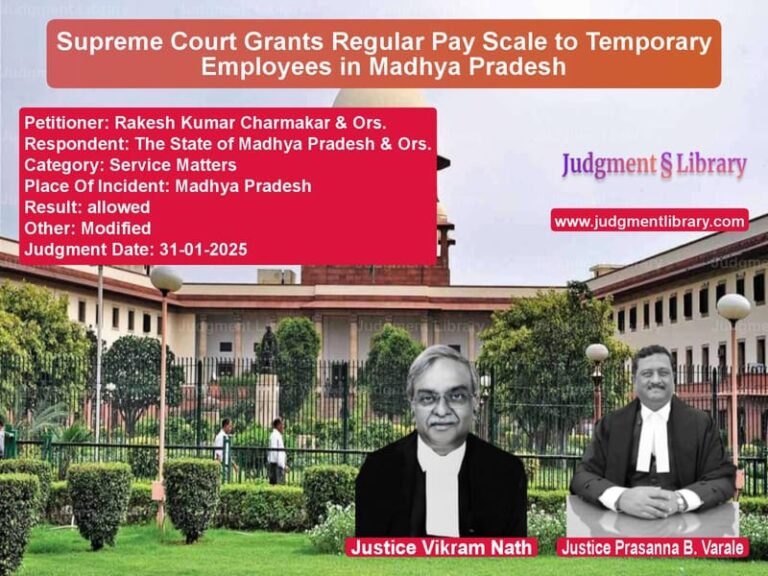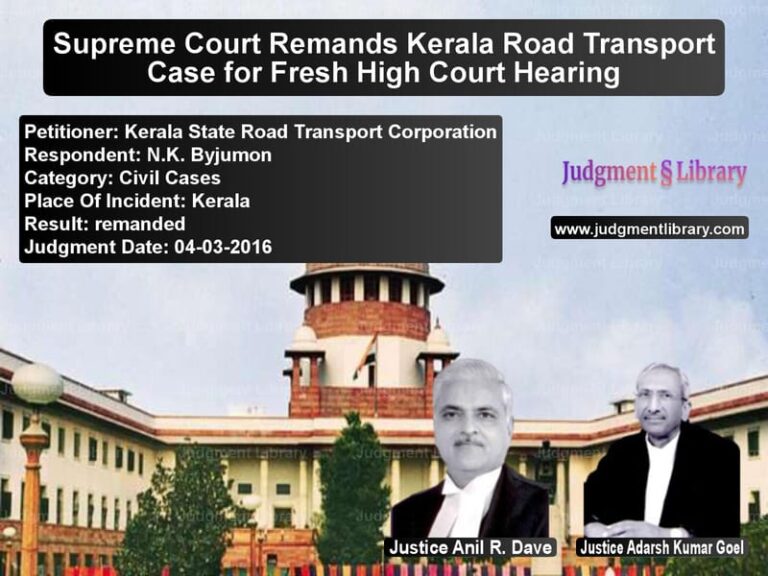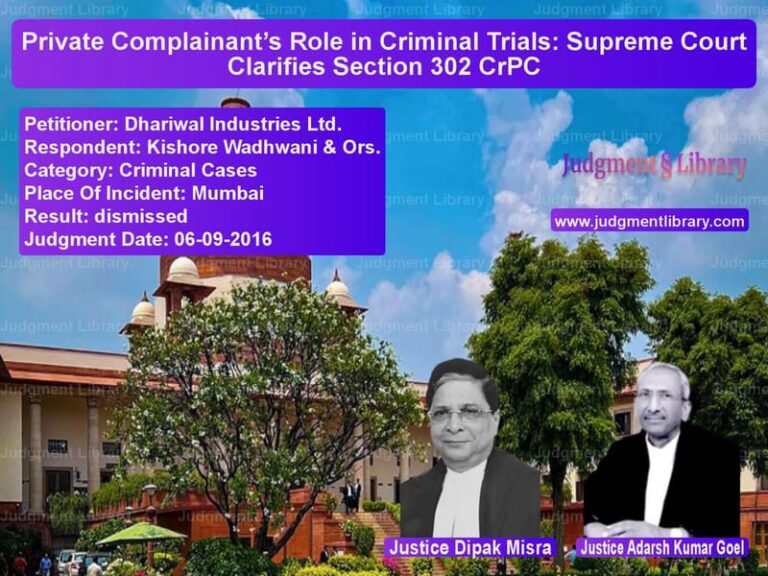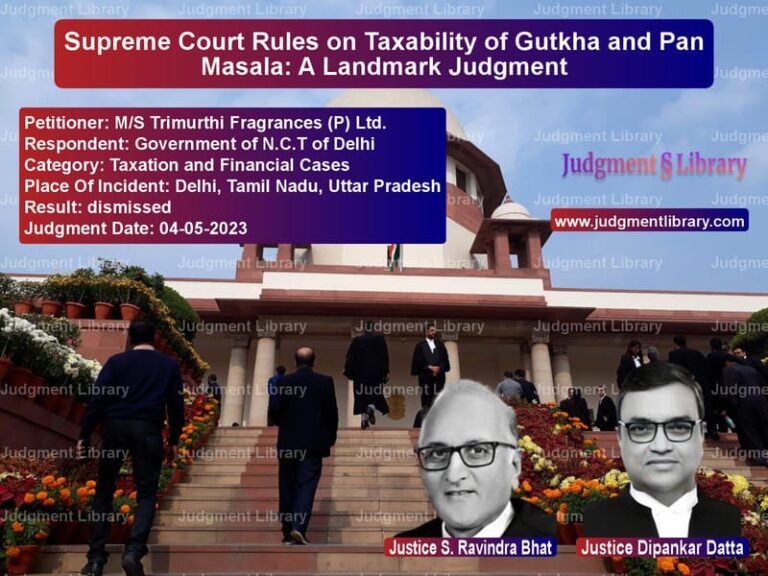Land Ceiling Laws: Supreme Court Orders Fresh Scrutiny of Plantation Land in Karnataka
The case of State of Karnataka vs. Y. Moideen Kunhi (D) by LRs. & Ors. deals with land reform laws, particularly the provisions of the Karnataka Land Reforms Act, 1961, which governs the ceiling on landholdings. The Supreme Court was tasked with resolving a dispute involving the application of the Act to lands held by the respondents, Y. Moideen Kunhi and his family, which were originally categorized as plantation land. The case arose from the contention between the State and the landowners regarding whether certain lands, including forested and plantation areas, should be considered excess land subject to surrender under the Act. The Court addressed the issue of land classification, the validity of the declarations, and the failure of authorities to adequately inspect the land before reaching a decision.
Background of the Case
The dispute began in 1975 when the respondents filed a declaration under Section 66(4) of the Karnataka Land Reforms Act, 1961, concerning their landholdings. The land in question included large tracts of plantation and forest land, including cardamom and rubber plantations. According to the sale deed dated 1957, the property was categorized into various sections, with some areas designated for agricultural and plantation purposes.
The declarants argued that their land fell under the exemption provided for plantation lands under Section 104 of the Act, which allows for the non-application of land ceiling restrictions. The Land Tribunal at Belthangady inspected the land in 1982 and determined that parts of the land were plantation areas, while other parts, including forest land, were excluded from the ceiling limit. Despite this, the State argued that the land was not properly classified and that the exemption was not applicable.
Petitioner’s Arguments (State of Karnataka)
- “The land in question is a large estate, and it was incorrectly classified as plantation land. Most of the estate was forest land and should be treated as excess land under the Act.”
- “The declaration under Section 66 was filed by the respondents, but they failed to provide accurate information regarding the land’s classification, leading to a false declaration.”
- “The respondents’ claims to the plantation exemption are not justified, as they did not prove that the land was used primarily for plantation purposes as per the definition under the Act.”
- “The land should be treated as excess, and the respondents must surrender the excess land to the State in compliance with the ceiling limits stipulated under the Karnataka Land Reforms Act.”
Respondent’s Arguments (Y. Moideen Kunhi & Others)
- “The declaration was made in good faith, and the lands in question have been used for plantation purposes, including cardamom and rubber cultivation.”
- “Under Section 104 of the Karnataka Land Reforms Act, plantation lands are exempt from the land ceiling restrictions, and the respondents are entitled to hold the land under the exemption provision.”
- “The inspection report submitted by the Special Tahsildar in 1982 confirmed that the land was primarily used for plantation purposes, making it exempt from the ceiling limits.”
- “The respondents have not provided false information or concealed any details about the land’s use. The objections raised by the State regarding the land’s classification were unfounded.”
Supreme Court’s Observations
The Supreme Court scrutinized the arguments presented by both parties and reviewed the relevant provisions of the Karnataka Land Reforms Act, particularly Sections 79A, 79B, and 104. The Court made several key observations:
- “The definition of plantation land under Section 104 of the Karnataka Land Reforms Act is clear, and the exemption applies to lands that are primarily used for plantation crops. The respondents provided sufficient evidence to show that a large part of their land was used for cardamom, rubber, and other plantations.”
- “The State’s argument that the estate includes forest land and should be treated as excess land is valid only if the land was not used for plantation purposes. The inspection reports from 1982 and 1983 clearly indicated that the land was primarily plantation land.”
- “The declaration filed under Section 66(4) of the Karnataka Land Reforms Act by the respondents was in accordance with the law, and there is no evidence of intentional misrepresentation.”
- “The State has failed to prove that the respondents had any ulterior motive in filing the declaration, and there was no reason to declare the land as excess without proper inspection.”
The Court stated, “The State’s argument regarding the applicability of Section 79B is misplaced. The exemption provided for plantation land under Section 104 is clear, and the respondents have provided sufficient documentation to prove their case.”
Final Judgment
The Supreme Court ruled in favor of the respondents and quashed the decisions made by the Karnataka High Court and the Land Tribunal:
- The declaration filed by the respondents under Section 66 of the Karnataka Land Reforms Act was valid.
- The land in question, primarily used for plantation purposes, was exempt from the land ceiling provisions under Section 104 of the Act.
- The orders of the Land Tribunal and High Court, which directed the respondents to surrender the land as excess, were set aside.
- The State’s appeal was dismissed, and the respondents were allowed to retain their land.
Implications of the Judgment
The ruling in this case has important implications for land reform laws and the classification of plantation land:
- The judgment reinforces the importance of accurately classifying land as plantation or non-plantation under the Karnataka Land Reforms Act.
- The Court’s emphasis on the necessity of proper inspection reports for land classification highlights the importance of due process in land disputes.
- The ruling clarifies that exemption from land ceiling laws applies to lands used for plantation purposes, even if the land includes other elements like forest or agricultural areas, provided the primary use is for plantation crops.
- This decision will likely impact future cases involving plantation land and land ceiling disputes in Karnataka and other states with similar land reform laws.
The Supreme Court’s judgment protects the rights of landowners who comply with the legal requirements for plantation land exemption, ensuring that their land is not subject to arbitrary land ceiling limits.
Petitioner Name: State of Karnataka.Respondent Name: Y. Moideen Kunhi (D) by LRs. & Others.Judgment By: Justice Deepak Gupta, Justice Aniruddha Bose.Place Of Incident: Karnataka.Judgment Date: 27-04-2020.
Don’t miss out on the full details! Download the complete judgment in PDF format below and gain valuable insights instantly!
Download Judgment: State of Karnataka vs Y. Moideen Kunhi (D) Supreme Court of India Judgment Dated 27-04-2020.pdf
Direct Downlaod Judgment: Direct downlaod this Judgment
See all petitions in Property Disputes
See all petitions in Landlord-Tenant Disputes
See all petitions in Environmental Cases
See all petitions in Judgment by Deepak Gupta
See all petitions in Judgment by Aniruddha Bose
See all petitions in dismissed
See all petitions in supreme court of India judgments April 2020
See all petitions in 2020 judgments
See all posts in Civil Cases Category
See all allowed petitions in Civil Cases Category
See all Dismissed petitions in Civil Cases Category
See all partially allowed petitions in Civil Cases Category







